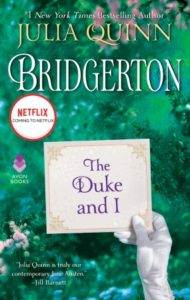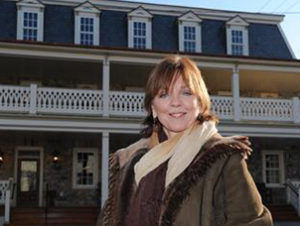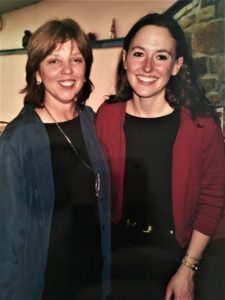This interview with historical romance bestseller Julia Quinn was originally published in RT BOOK Reviews magazine (print edition) as “Sitting Down with Julia Quinn.” An abridged version appears below. Enjoy and happy #TBT!
Interview with Historical Romance Author Julia Quinn
I recently chatted up bestselling historical romance novelist and triple RITA® Award winner, Julia Quinn. Here’s what she had to say about globetrotting on the cheap, the unexpected inspiration of really bad music, and why Happily Ever After really is the best way to go in real life as well as fiction.
Infrequently Known JQ Facts
HCT: You sat down to write your first romance novel when you were a college senior at Harvard and went on to publish your first few novels when you were going back-and-forth in your head about pursuing medical school. Less well known is that in the early ‘90s you worked as a writer and researcher for Let’s Go: Europe. That must have been a fun job. Can you tell us a bit about that?
JQ: It was a terrific job, but I don’t think I’d describe it as fun. Let’s Go: Europe is designed for the budget traveler, so to make sure it contains the most relevant information, researcher/writers are dispatched on strict budgets. I was given airfare and $32 a day to survive on Crete and Cyprus. Trust me when I tell you that $32 a day did not go far even in 1990. I stayed in many youth hostels, survived an infestation of fleas and was propositioned by a monk.
But on the other hand, I learned a tremendous amount about resourcefulness and resilience. It was the first time I’d ever spent more than a week in a non-English-speaking country (most important words in Greek: “Oil,” “Vinegar,” and “Boyfriend in America”), and this was pre-Internet, pre-cell phone. I was truly separated from my friends and family. If I wanted to call home, I had to find a hotel that didn’t charge exorbitant rates and get them to place an international call for me, which might or might not go through.
1990 was also pre-laptop, so I had to do all of my writing and editing by hand. I traveled with a copy of the previous year’s books (both Let’s Go: Europe and Let’s Go: Greece & Turkey), several 8.5 x 11 notebooks, carbon paper, scissors, and a glue stick. Anything I wanted to keep from the previous edition I had to cut carefully from its pages and glue-stick it into the notebook. New stuff I wrote by hand. Oh, and I had to use carbon paper so that I had copies in case my writing got lost in the mail. I’m not sure what we would have done if that had actually happened. The carbon copies were missing all of my glued-in bits. I have a feeling current researcher writers have it a lot easier.
HCT: You were the first romance writer to ever do a book signing at the Borders in Singapore. What does it feel like to meet fans of your books in a culture so different from the U.S. but also from the U.K. where your historical romances are set? Is the language of love and love stories truly universal? Are there any differences, cultural or other, that stand out in memory?
JQ: I visited Singapore in 1999 before my career had really taken off, so I don’t know if I actually had any fans there before my signing! Mostly I remember how grateful everyone was that an American author had taken the time to visit their country and do a book signing. I would love to do more international signings. I have a very active Facebook Fan Page, and I’m constantly amazed at how international my readership is. Sadly, I have not yet managed to convince my publishers that I need to be sent on a world tour. 😉
What’s Next in Historical Romance for JQ?
HCT: You recently contributed to a three-part novel, The Lady Most Likely, with fellow bestselling romance authors, Eloisa James and Connie Brockway. How did the project come about? What process did you three follow for brainstorming, plotting out, and finally writing and editing the work? Were there any ahem…clashes?
JQ: No clashes! I think there might have been one time where we argued over comma usage, but that’s it.
The project came about during a conversation Eloisa and I were having about anthologies. We both love writing in the novella format, but several readers had told us that they found novellas to be too brief. Eloisa came up with the idea of integrating three love stories into one longer, cohesive novel. We asked Connie to join in because we’re both such big fans of her writing.
We had a terrific time putting the project together. We had a very brief three-paragraph description of the plot when we sold the book, but that was it, so we met for a long weekend in New Orleans to work out the plot and characters. Then there was quite a bit of emailing that went back and forth. We had such a good time with it that we’re already planning another!
HCT: Your latest release, Just Like Heaven, went on sale May 31st. This is the start of yet another new series for you, the Smythe-Smith Quartet. Can you tell us a bit about who we’ll meet as the hero and heroine in the book and about the series overall?
JQ: Years ago I wrote a scene in which my hero and heroine found themselves at the worst musical concert known to man. It was the annual Smythe-Smith Musicale, during which Mozart was butchered so badly it was a wonder he didn’t rise up from his grave in agony. I had so much fun with the scene that I found myself bringing back the Smythe-Smiths in later books. I figured it was an annual event—there was no reason my other heroes and heroines couldn’t be forced to sit through bad music.
But there was always one girl up on the stage who seemed to understand just how bad the quartet really was. Readers begged me to tell her story. So of course I decided to write one for one of the other girls—Honoria Smythe-Smith, who smiled widely during the concert as she attacked her violin. It turns out she is very much not in love with Marcus Holyroyd, her brother’s best friend since childhood. And Marcus is definitely not in love with her.
That’s when the fun begins.
But for those of you wanting the story of the girl who actually can play music, have no fear—it’s coming. Since there are four musical spots in a quartet, I decided to write a quartet of books.
HCT: More so than a rapport, you really seem to have a relationship with your readers. Offering up the epilogues to your Bridgerton books—second epilogues, even—as e-downloads seems to underscore the reciprocity of that loyalty. Most authors write sequels or novellas in anthologies, not 30 page epilogues. How did you first come up with this innovative idea? Any update on when the publisher, Avon/ HarperCollins, will be issuing the compilation of the eight epilogues into a print volume?
JQ: The 2nd Epilogues came about because so many readers were contacting me and asking, “What happened next?” And all I could answer was, “I don’t know.” The great thing about writing romance is that it ends rather neatly. The main characters fall in love and we all know that they will live happily ever after. So when I finish a book, I don’t really think about what happens to my characters unless I have some compelling reason to do so—usually if they are going to make an appearance as secondary characters in another book.
After I’d said, “I don’t know,” about a hundred times, I started thinking—if I were to offer updates on the characters, how would I do it? I came up with the idea of “2nd Epilogues,” which are essentially short stories that take place sometime after the novel ends. The novel is absolutely 100 percent complete without these 2nd Epilogues; rather, they are extras or treats if you will, for my most devoted readers.
Right now the 2nd Epilogues are only available as electronic downloads, but we do plan to release them in a print collection, hopefully at the end of 2011.
Final Thoughts
HCT: Have you ever had a Fan Girl Moment with another Big Name Author? You know, one of those tongue tying, almost pants’ peeing moments of sheer, awestruck delight?
JQ: I do remember being terrified to meet Lisa Kleypas very early on in my career. I was such a fan of her work. I think I’d read Then Came You and Dreaming of You a hundred times each. Now it seems ludicrous to have been so scared. Lisa is quite possibly the nicest, most approachable, and generous person I’ve ever met. But hey, I didn’t know that then!
HCT: Your undergraduate degree is in Art History and you were accepted into Yale School of Medicine and Columbia College of Physicians & Surgeons. Quelle choice! You’ve been a researcher/reporter for a well–known travel magazine and have traveled widely both personally and professionally. Oh, and you’ve written a bunch o’ bestselling books, including your famous Bridgerton series, beloved the world over. On the personal front, you’ve been married to your personal Prince Charming since 1996. To stave off the rest of us from spiraling into existential insecurity, tell us, JQ, is there anything you can’t do really well that you wish you could? Even better, is there anything you positively suck at?
JQ: I can’t turn a cartwheel. I cannot tell you how much emotional anguish this has caused me. (And lest you think I’m being sarcastic, ask any fourth-grade girl! Cartwheels are a necessity!) I actually decided that I was going to learn how to cartwheel for my 40th birthday. It seemed like one of those awesome, I-Am-Woman-I-Can-Do-Anything things that are perfect for milestones.
Didn’t happen.
HCT: I adore the tagline used throughout your web site: Because happily ever after is a whole lot of fun. It feels like a philosophy of life as much as a branding device. And it certainly fits with your books which even for romances stand out as so sunshiny and upbeat, as well as meticulously well-researched and, for want of a better word, smart, that reading one is like biting into a crisp autumn apple—good all the way through. The first JQ book I read was The Viscount Who Loved Me and I still remember that after I finished my face hurt from so much smiling. Have you always subscribed to happily ever after is a whole lot of fun? Or is this something you’ve come to over time? Feel free to borrow Lady Whistledown’s infamous quill and give us some pithy commentary or better yet, advice.
JQ: I’ve never been attracted to bad boys. I just don’t think love should be hard. Life throws you enough curve balls—illness, money woes, freak accidents—love should be the easy part in all of this. It should be thing that gets you through all the other stuff. I married my best friend, and it sure has made my happily ever after a lot of fun.
HCT: Your website at JuliaQuinn.com is so cool and comprehensive. It covers everything to do with your books, which are listed by series and title, your news & events, the charities you favor (love that!), and your roster of not only the foreign language editions of your books but also your personal overseas travels. Can you tell us one thing, PG-13, of course, that isn’t there?
JQ: It all comes back to that lecherous monk… 😉




